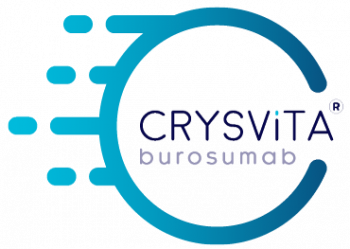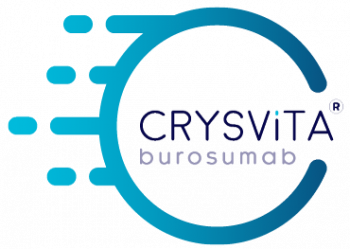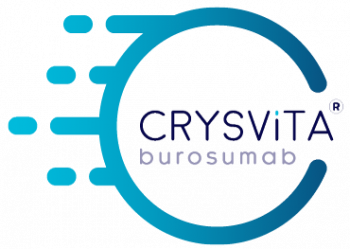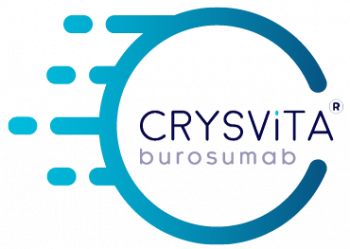Welcome to the CRYSVITA® website for Australian HCPs
CRYSVITA® (burosumab) is indicated for the treatment of X-linked hypophosphataemia (XLH) in adults, adolescents and children 1 year of age or older. 1
What is XLH?
XLH is a rare, genetic, progressive and life-long phosphate wasting disorder, caused by mutations in the PHEX gene that leads to excess FGF232–7
How does CRYSVITA® work?
CRYSVITA® is a recombinant human monoclonal IgG1 antibody that binds to and inhibits the biological activity of fibroblast growth factor 23 (FGF23), present in excess in X-linked hypophosphataemia. Neutralisation of FGF23 by CRYSVITA® increases renal tubular reabsorption of phosphate and the serum concentration of 1, 25 dihydroxy-Vitamin D. 1
Why CRYSVITA®?
The efficacy and safety of CRYSVITA® in children (aged ≥1 year) and adults with XLH has been studied in a global clinical development programme, comprising phase II and phase III clinical trials 8-13
Starting CRYSVITA®
CRYSVITA® is indicated for the treatment of X-linked hypophosphataemia (XLH) in adults, adolescents and children 1 year of age or older.1
Resources to support the management of XLH
Resources include a Dosing and Administration Guide, Injection Guide, Prescribing Guide, Patient Starter Guide and more.
Adverse Event Reporting:
Australian regulations require that matters potentially impacting patient safety, including suspected adverse events and side effects are documented and reported. Information reported shall be managed in accordance with Australian Privacy Law and regulations laid out by the Therapeutic Goods Administration (TGA) of Australia. To report such matters, please e-mail …
1. Australian Product Information for Crysvita® (burosumab) approved 10 September 2021. https://www.kyowakirin.com/australia/our_medicines/doc/crysvita_product_information_leaflet.pdf. Last updated: Sept 2021 Last accessed: March 2023. 2. Beck-Nielsen SS, et al. Orphanet J Rare Dis. 2019;14:58. 3. Carpenter TO, et al. J Bone Miner Res. 2011;26:1381–88. 4. Endo I, et al. Endocr J. 2015;62:811–16. 5. Haffner D, et al. Nat Rev Nephrol. 2019;15:435–55. 6. Martin A & Quarles LD. Adv Exp Med Biol. 2012;728:65–83. 7. Rafaelsen S, et al. Eur J Endocrinol. 2016;174:125–36 8. Carpenter TO, et al. N Engl J Med. 2018;378:1987-98. 9. Whyte MP, et al. Lancet Diabetes Endocrinol 2019;7:189-99. 10. Imel EA, et al. Lancet. 2019;393:2416–27. 11. Insogna KL, et al. J Bone Miner Res. 2018;33:1383–93. 12. Portale AA, et al. Calcif Tissue Int. 2019;105:271–84. 13. Insogna KL, et al. J Bone Miner Res. 2019;34:2183–91.






